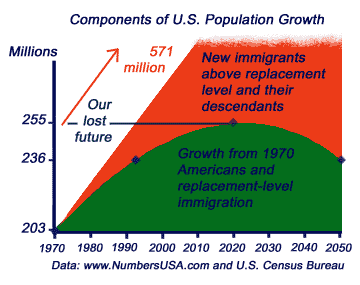|
Overview: Population Birth rates Immigration Solutions Numbers Cites Terms |
U.S. immigration and population growthUnless we act to change our country's immigration policies, U.S. population will double this century - practically within the lifetimes of children born today.5 By the year 2020, if current population trends continue, the U.S. will add enough population to create another New York City, Los Angeles, Chicago, Philadelphia, Baltimore, San Francisco, Indianapolis, San Jose, Memphis, Washington D.C., Jacksonville, Milwaukee, Boston, Columbus, New Orleans, Cleveland, Denver, Seattle, and El Paso - plus the next 75 largest cities in the U.S.3 - if we don't act now to stabilize U.S. population. Population growth is influenced by three factors: mortality (the death rate, which has been steadily decreasing in the U.S.2), birth rates or fertility (children per woman) and net immigration (immigration minus emigration).29 Unlike in developing countries, fertility (children per woman) is no longer the significant contributor to U.S. population growth. In fact, overall U.S. fertility is slightly less than replacement level and has not exceeded replacement level since 1972.11 
Immigration is the largest factor contributing to population growth in the U.S. Immigration contributes over 2.25 million people to the U.S. population annually (1.5 million legal immigrants and illegal immigrants as of 2001-2002, now estimated at 1.7 million in 2003) plus 750,000 births to immigrant woman annually).31, 38 The total foreign-born population in the U.S. is now 31.1 million, a record 57% increase since 1990. 9-11 million of those are here illegally - a 4.5 million increase since 1990. Population has been a concern of environmentalists since the first Earth Day in 1970. Had we stabilized immigration at replacement numbers in 1970, U.S. population would have stabilized at 255 million in 2020 and then gradually decreased to an environmentally sustainable level. Yet Congressional immigration policy changes starting with the 1965 Amendments to the Immigration and Nationality Act has increased immigration six-fold. The first manifestations of this increase were realized by the first Earth Day in 1970. Current immigration levels are driving U.S. population to double this century. Historically, post l970 immigrants and their descendants have added between 35 and 45 million people to America's population in less than 30 years. Unfortunately, this flow of people into the U.S. has not relieved population pressures in the countries of origin. During the this period of time the populations of most developing countries (including Central America, Mexico, China and Central America) have continued to grow.30 Clearly, we are not able to solve the world's population problems by attempting to absorb their excess population. Because our high resource consumption is exacerbated by our intake of immigrants, our population growth is compromising the environmental futures of not just our own country, but of the rest of the world - from many other countries from which we extract resources. Paul Ehrlich, author of "The Population Explosion"35, said: "Overpopulation in rich countries is, from the point of view of the Earth's habitability, more serious than rapid population growth in poor countries." An NPG demographic analysis of age distribution, fertility, and mortality data shows that if there had been no immigration to the U.S. since 1990, the population in 2000 would have been 262 million - 19 million less than the 281 million counted. Thus, post-1990 immigrants and their children accounted for 61% of U.S. population growth during the last decade.32 Looking toward the future, at least 70% of our projected population growth this century will be caused by mass immigration - that is, by recent immigrants and their descendents.33 In 1972, two population commissions - the President's Commission on Population Growth and the American Future, headed by John D. Rockefeller III, and the Select Commission on Population, headed by Father Theodore Hesburgh, president of Notre Dame - concurred that U.S. population must be stabilized and that immigration policy would have to respect this demographic reality.6 The facts are clear. To preserve and protect our environment, the Sierra Club must, in addition to focusing on fertility and consumption, acknowledge the large part that current immigration numbers play in U.S. population growth and acknowledge the need for lower levels of immigration into the U.S.
Next: Author: Fred Elbel. Edited by Dick Schneider. |